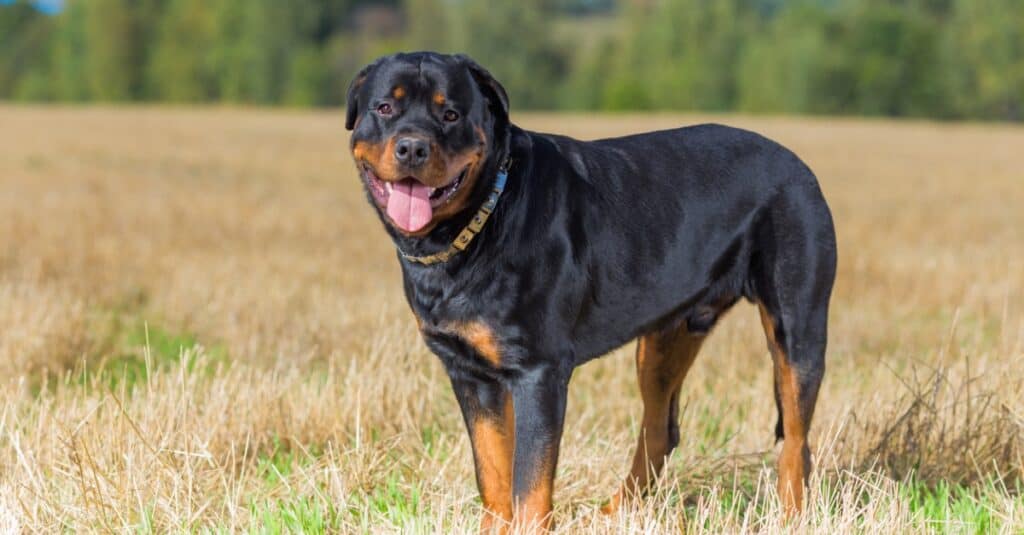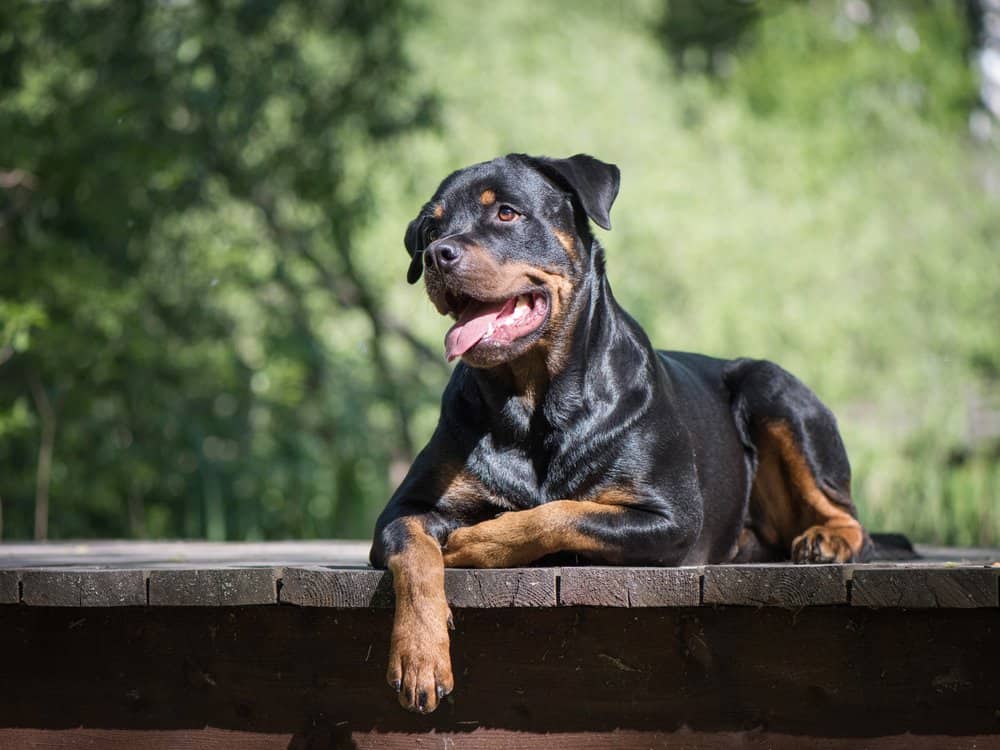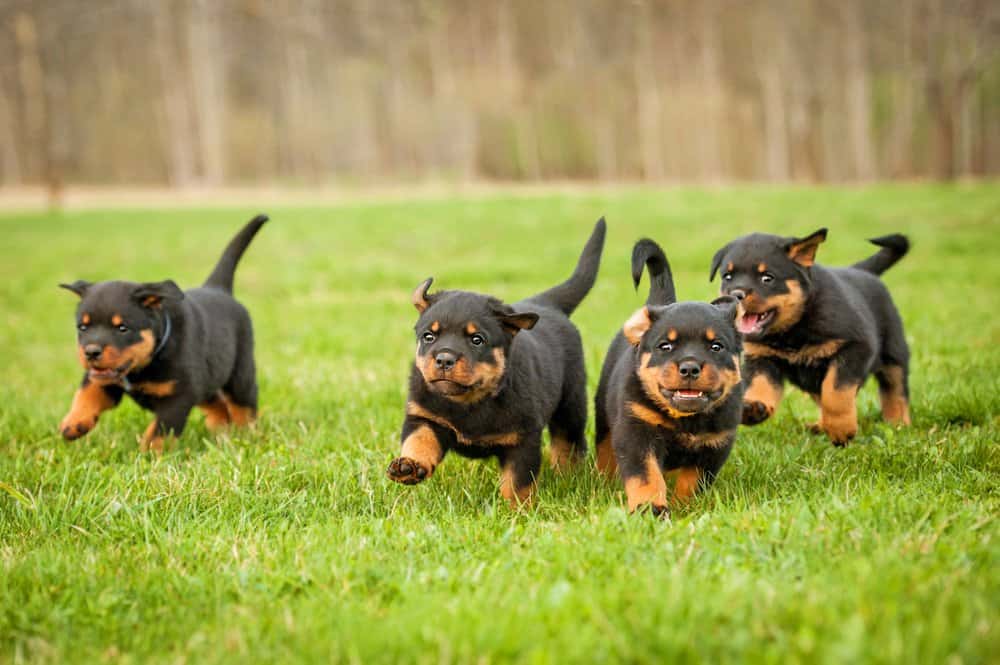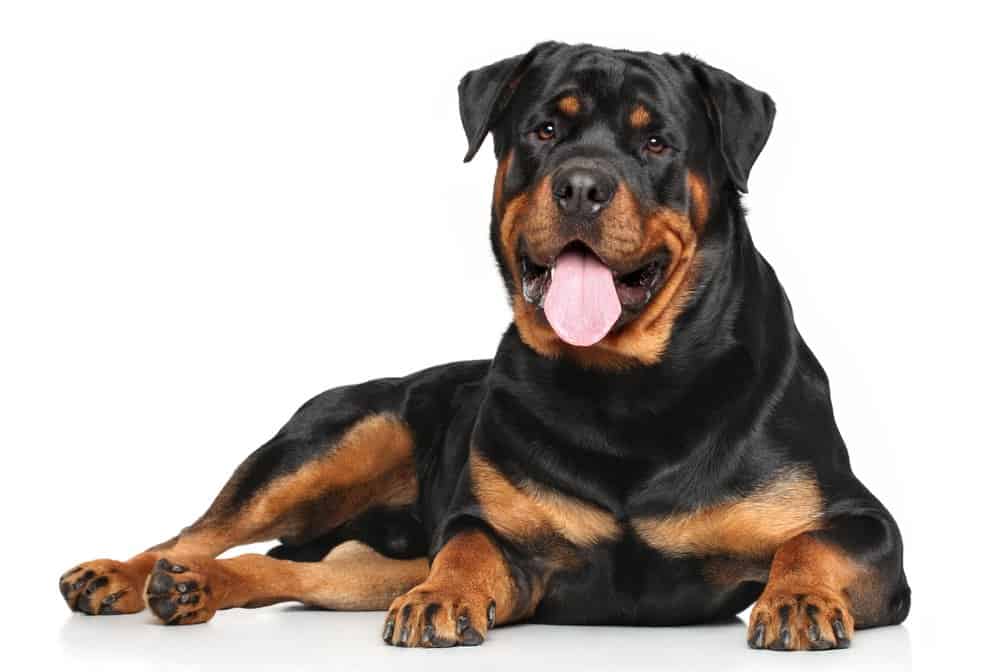If you are an animal lover, then you are likely familiar with the beloved rottweiler. The rottweiler is one of the most recognizable dog breeds out there, as their striking features have made quite a name for themselves. Not only does this breed possess the stunning coat markings that everyone knows and loves, but they are also one of the most loyal companions around. Their loyalty and protective nature has led to them often filling guard dog roles, but they have filled other important working roles as well. If you are interested in welcoming a rottweiler into your family, then there is a lot you will need to know about rottweiler progression!
We want you to have the tools needed to be the best rottweiler parent possible, so let’s discuss everything you need to know below! In this article we will dive into the rottweiler growth chart by age, teething information, training tips, and more! Let’s get started.
Brief Rottweiler Summary

The rottweiler was originally bred to herd livestock and pull carts for farmers.
©iStock.com/Ideas_Studio
The rottweiler might be popular around the world these days, but they got their start in Germany in the early 1900’s. The breed was originally created to pull heavy carts for farmers and drive cattle, which is why the rottweiler has such a muscular composition! They needed their sturdy frames to perform the hard work alongside their farmers.
The rottweiler still possesses many of the traits they originally used for work and is why the breed is known for being so loyal and protective of their family to this day. While the rottie takes guarding their family seriously, they can also be goofy and kind when they are around those they love.
They may be a bit aloof and observant when first meeting new people, but once they come around, they are a bundle of fun. When the rottweiler is raised in a home that prioritizes socialization and confidence building, they can become the well-rounded, family pup of your dreams.
Rottweiler Growth & Weight Chart By Age
The rottweiler is a large canine friend, so most future rottie owners would like a run-down of their growth throughout the first year of their life. We want you to know what’s ahead each step of the way, so let’s break down their monthly weight throughout the rottweiler’s first year.
| Age | Male Weight | Female Weight |
|---|---|---|
| Birth | About 1 pound | About 1 pound |
| 1 Month | 4-8 pounds | 3-6 pounds |
| 6 Weeks | 8-11 pounds | 4-9 pounds |
| 2 Months | 12-16 pounds | 10-14 pounds |
| 3 Months | 34-39 pounds | 30-35 pounds |
| 4 Months | 44-51 pounds | 35-42 pounds |
| 5 Months | 54-61 pounds | 45-55 pounds |
| 6 Months | 62-71 pounds | 59-64 pounds |
| 7 Months | 72-80 pounds | 65-70 pounds |
| 8 Months | 75-85 pounds | 70-75 pounds |
| 9 Months | 90-105 pounds | 70-80 pounds |
| 10 Months | 95-110 pounds | 75-85 pounds |
| 11 Months | 95-115 pounds | 75-90 pounds |
| 12 Months | 95-125 pounds | 80-95 pounds |
| 2 Years | 95-135 pounds | 80-105 pounds |
As you can see, rottweilers can reach impressive sizes! There is typically a slight weight difference from male to female rottweilers, but no matter which one you have in your home, they are sure to be a huge pup!
When Will My Rottweiler Stop Growing?
Anytime you have a large to giant breed dog, they will typically grow until they have reached two years of age. While most of their growth will occur during the first year of their life, these pups will continue to fill out until they are two years old. This is certainly the case for our beloved rottweilers!
If you adopt an adorable rottweiler puppy, then they may not reach their true adult size until they are two years old. While you can typically have an idea of just how big your rottie will be once they hit one year of age, just expect them to pack on a few extra pounds in the year to follow as well.
How Big Will My Rottweiler Be When Fully Grown?
As we discussed above, most rottweilers will grow until they have hit two years of age. There will likely be a size difference between male and female rottweilers, but we can offer you an average on what lies ahead!
Most adult rottweilers will weigh anywhere from 80-135 pounds, and they can stand up to 27 inches in height at the shoulder. Though this is typically what you can expect from your rottweiler companion, we always suggest learning about the size of your rottie’s parents. This is always the best indicator of your rottweiler’s eventual size.
The Biggest Rottweiler On Record
The average rottweiler can already reach impressive sizes, but a rottweiler named Blondie has tipped the scales and set an incredible record for the breed! While the average rottweiler will weigh up to 135 pounds, Blondie weighs a remarkable 195 pounds!
Blondie may be a large canine friend, but he is known for being a gentle giant. His owner says he is well behaved and trustworthy, so while he may be the biggest rottweiler on record, he is just a big teddy bear.
If you thought Blondie was impressive, check out the biggest dogs in the world!
When Should My Rottweiler Stop Eating Puppy Food?

Puppy food is very important for your growing rottweiler pup!
©Rita_Kochmarjova/Shutterstock.com
For a dog as big as the rottweiler, puppy food is essential to help them grow big and strong without a hitch. Dog food for puppies is fortified with ingredients that promote optimal growth for our canine friends, and it also contains extra calories per cup that can keep up with their daily energy requirements. Puppy food is necessary for all growing canine friends, but it is even more critical for dogs that grow rapidly during their first year of life.
Since puppy food nourishes the body as the dog grows, this means you should offer your rottweiler puppy food until they have reached their adult size. While your rottweiler may continue to fill out until they have reached two years of age, they should complete most of their growth by the time they reach 18 months of age. As long as you give your rottweiler an approved puppy kibble until they are 1.5 years old, they should have all they need to grow into a strong adult!
When Will My Rottweiler Start & Stop Losing Teeth?
Humans have a set of baby teeth that they lose as they grow into adulthood, and our rottweiler friends are no different! The period in which they lose teeth is much shorter than it is in humans, but there is a set timeframe in which you can expect to find the occasional rottweiler baby tooth around your home!
When your rottweiler hits three weeks of age, you will start to see their baby teeth erupt through their gums. They will likely grow these baby teeth over a period of a few weeks, and they should have a full set of sharp puppy teeth by the time they are six weeks old.
Just as our baby teeth don’t stick around for long, the rottweiler puppy is no different. Your rottweiler puppy will start to lose their baby teeth once they hit 12 weeks of age, and this is due to their permanent teeth growing in and pushing out their baby teeth. They will continue to lose their puppy teeth for six months, but they should have a full mouth of permanent teeth once they reach six to seven months.
When Should I Start Training My Rottweiler Puppy?
The rottweiler can be a wonderful addition to your home, but proper training and socialization needs to be a priority from the moment you adopt them. The rottweiler is not a dog for beginner pet parents or those that are not aware of their training needs, as the breed is known for being very intelligent and quite stubborn. Intelligence is a wonderful trait in a dog, but it often means they require a bit more in terms of training and daily stimulation.
Rottweilers require consistent and firm training from the moment they enter your home. Most pups respond to basic obedience training from eight weeks of age and on, and this is true for the rottweiler as well. No matter how old your rottweiler is at the time you adopt them, it is the perfect time to dive into a training routine.
Just remember that in addition to implementing basic obedience training, you should also focus on socialization for your growing rottweiler. Rottweilers are known to have a protective nature and an ingrained need to guard those they love, and this can lead to some troublesome behavior if the rottie is not socialized. If your rottweiler is not comfortable around unfamiliar people and animals, this can lead to aggressive behavior.
Socialization
Ideal socialization for the rottweiler would involve introducing them to new people (in and outside of your home), bringing them around safe and friendly canine friends, taking them to new settings, and exposing them to unfamiliar sounds. When doing this from the moment you welcome your rottweiler into your home, your pup has the best chance at becoming a safe and well-rounded family member!
Before your rottweiler is introduced to unfamiliar dogs, be sure that they are fully vaccinated against parvovirus and canine distemper. This is essential for all canine friends, but it’s critical for a rottweiler puppy. Rottweilers are known to be more susceptible to parvovirus and appear to be hit much harder by the virus than other breeds. This is why it is so important to make sure your rottweiler puppy has received all three vaccines in their puppy vaccination series.
What Commands Should I Teach My Rottweiler First?
Now that you know just how important a training routine is for your rottweiler, you may be curious as to which commands you should teach them first. This can vary based on what is essential in your home, but there are a few basic commands that we think all rottweilers should learn!
The first commands that you should focus on for your rottweiler include:
- Sit
- Stay
- Come
- Lay down
- Drop it
Not only are the above commands important for your rottweiler to learn, but you should also be socializing your rottie at the same time. With basic obedience and socialization on your side, your rottweiler has the best chance at success!
When Should My Rottweiler Be Potty Trained?

Most rottweilers are fully housebroken within three to four months of their potty-training beginning.
©EKATERINA SOLODILOVA/Shutterstock.com
Not only will you need to focus on basic obedience training when you adopt a rottweiler puppy, but you will need to put some time into potty training as well. Potty training is one of the more challenging parts about raising a puppy, but rottweilers seem to catch on quickly in comparison to other canine friends!
As long as you are consistent about your rottweiler’s potty training and daily routine, then most rotties will be fully housebroken within three to four months of their training being implemented. We know how frustrating it can be to potty train your puppy, but your growing rottweiler should catch on in no time!
When To Spay or Neuter Your Rottweiler?
If you are not interested in breeding your rottweiler, then you may be planning to spay or neuter your pup. Many pet parents are aware of the health benefits that sterilization can offer. But you may not know when it is the best time to spay or neuter your rottweiler. There is quite a bit of information out there about the consequences of sterilization at the wrong time. We want to help you make the best decision for your rottweiler companion.
Most veterinary professionals will agree that spaying or neutering between the ages of six months to one year is ideal. Waiting until six months of age appears to eliminate many of the risks that come with sterilizing too early. Sterilizing before one year of age is ideal to cut down on bad behaviors that are driven by hormones. We still suggest speaking with your vet about what is best for your beloved pup.
Health Issues to Be Aware of in Rottweilers
Most rottweilers will live a long and happy life of up to 12 years of age. But there are some health conditions that rotties are more prone to developing throughout their life. The conditions we list here cannot typically be prevented. However, being aware of them can allow you to jump into action the moment they develop.
Joint Disease
Rottweilers are prone to developing joint disease due to their large size and hereditary links to joint abnormalities. The abnormal hip formation known as hip dysplasia is commonly seen in rottweilers. It can often lead to arthritis as a result. Some of the most common symptoms include stiff joints, changes in gait, and difficulty rising after rest. Stiffness after exercise, muscle wasting in the hind end, limb sensitivity, and joint swelling are also common.
Eye Conditions
Rottweilers are prone to a few different eye conditions, ranging from cataracts to entropion. These issues often lead to physical changes of the rottweiler’s eyes, and this can include everything from red eyes to noticeable changes of the lens. We suggest always seeking medical care if you notice any sudden changes in your dog’s eye appearance.
Cardiac Arrest
Cardiac abnormalities seem to occur at a higher rate in rottweilers. This can increase their risk of cardiac disease down the line, and it often requires long term medical management. Common symptoms of cardiac disease in rottweilers include chronic coughing, breathing changes, tiring with exertion, and abdominal swelling.
Bone Cancer
Unfortunately, bone cancer occurs in a higher rate in our rottweiler friends. This form of cancer requires early intervention to offer the dog the best chance at recovery, so being aware of the symptoms is essential. Common signs of bone cancer in rottweilers include limping, limb pain, and limb swelling.
Your rottweiler may never experience any of the health issues we listed above, but it’s still important to be on the lookout for these complications throughout their life!
Pictures Of Rottweilers as Puppies

Puppies are full of energy! Here, a litter of adorable rottweiler puppies run in the grass.
©Rita_Kochmarjova/Shutterstock.com

Even as a puppy, a rottweiler is quite large.
©iStock.com/Meagan Jenkins
Pictures Of Rottweilers Around 6 Months

A young rottweiler around eight to 10 months of age will be quite bulky!
©iStock.com/Jozef Culák
Pictures of Fully Grown Rottweilers

A adult rottweiler is a stunning pup!
©Jagodka/Shutterstock.com
Do you think the rottweiler is the perfect dog for your family?
The photo featured at the top of this post is © nicolas.fontana/Shutterstock.com
Ready to discover the top 10 cutest dog breeds in the entire world?
How about the fastest dogs, the largest dogs and those that are -- quite frankly -- just the kindest dogs on the planet? Each day, AZ Animals sends out lists just like this to our thousands of email subscribers. And the best part? It's FREE. Join today by entering your email below.
Thank you for reading! Have some feedback for us? Contact the AZ Animals editorial team.






